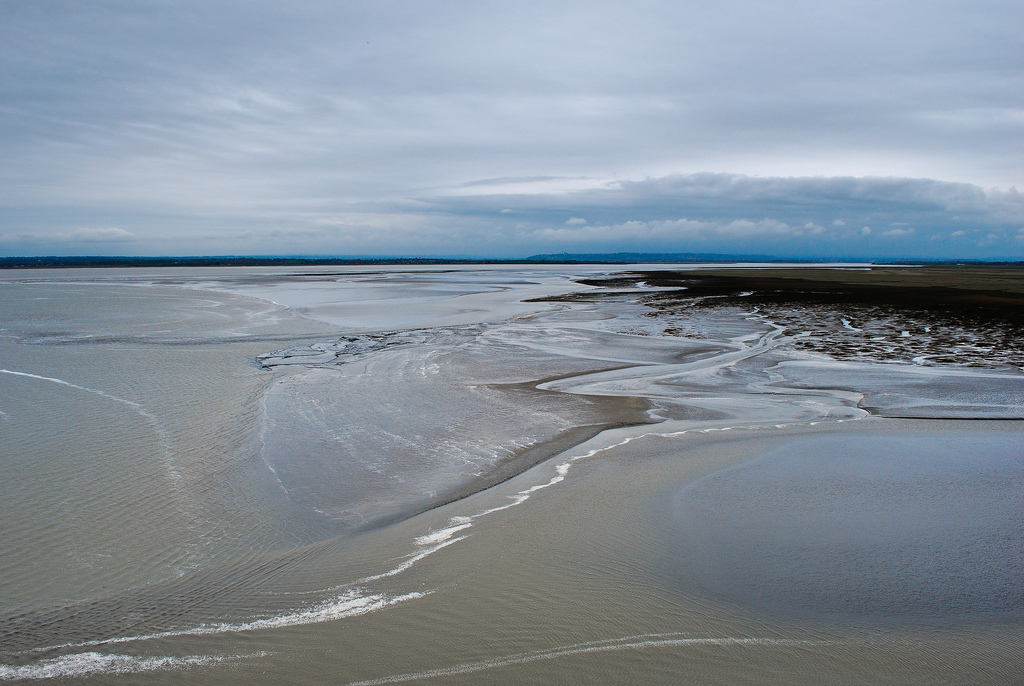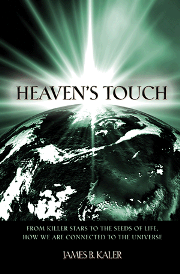
Heaven’s Touch: From Killer Stars to the Seeds of Life, How We Are Connected to the Universe
by James B. Kaler
-Reviewed by Jodie C. Liu
 Clear autumn nights in Alaska host the world’s longest running light show. For no longer than ninety minutes at a time, banners of green, purple and red light unfurl across a dark sky flecked with bright stars. The actions that produce the aurora borealis are a less dreamy picture: solar wind particles bombard the Earth’s magnetic field. The pretty lights are the product of the external cosmos battling to infiltrate the Earth system, in the process altering short-wave radio propagation and disrupting the current flows of long-distance power lines.
Clear autumn nights in Alaska host the world’s longest running light show. For no longer than ninety minutes at a time, banners of green, purple and red light unfurl across a dark sky flecked with bright stars. The actions that produce the aurora borealis are a less dreamy picture: solar wind particles bombard the Earth’s magnetic field. The pretty lights are the product of the external cosmos battling to infiltrate the Earth system, in the process altering short-wave radio propagation and disrupting the current flows of long-distance power lines.
Astronomer James Kaler understands this interaction between the Earth and the beyond better than most. In Heaven’s Touch, he captures this continuity of the universe. Covering everything from “killer stars” to the fundamental elements of life on Earth, Kaler unveils the unexpected but meaningful ways in which the Earth is inextricably connected to the outer reaches of the cosmos as if by an invisible celestial thread. Despite the apparent uniqueness of Earth, Kaler explains, no planet is an island, either.
The dependable ebb and flow of tidal waves was, Kaler notes, “a powerful motivating factor in the early belief in astrology, that the heavenly bodies affect affairs on Earth.” Even now, equipped as we are with an understanding of gravity, it still seems mystifying that the distant moon could move the vast oceans on a schedule that runs like clockwork. Tides are one of the natural phenomena that “are on Earth, but not of Earth, as their production lies in the heavens.” Lightning could be another. Scientists have long understood lightning as an electrical discharge from the atmosphere to the ground, but the precise trigger may transcend our Earth system. Kaler explains that there is growing consensus that lightning sequences are in part triggered by cosmic rays from outer space showering “ultra-high-speed electrons” into the atmosphere.
More alarming and unpredictable cosmic influences are in play as well. “Killer stars,” as Kaler calls them, many times as massive as our sun and, in the event of explosion, can eradicate any living matter on planets within a 30 light year radius. Extremely massive stars can also produce gamma ray bursts that pose a serious threat to any life form within 6,000 light years – a “monstrously large volume” around the Earth “that contains a large number of massive stars, including some of the most massive known.”
Luckily for us, gamma ray bursts are rare enough that the Earth might only experience one every billion years, but they emphasize Earth’s vulnerability and our place within the universe. Only by viewing the cosmos as a whole do we achieve a more accurate sense of scale. Compare, for instance, Eta Carinae, the largest star known to us ringing in at 100 times as massive as the sun, to a single hydrogen atom in the human body – these are both celestial matter of the same origin. It is a stunningly simple point with far-reaching consequences.
Excerpt: “A starry sky, twinkling lights in a velvet firmament, distant Suns; they enter our arts, our music, poetry, legends, and perhaps most important, our philosophies. But as we vividly see, they also reach out to us to touch us directly in a variety of ways, as does the Moon, the Sun, the other planets in our Sun’s System. Their touch can be destructive, to be sure, but it’s also creative. Without it there would be no life at all, indeed, in the grander scheme, there would be no Earth. Look what it took to make us. The Sun was born from a cloud of dusty interstellar gas that was most likely compacted by a supernova shock wave. We in fact find decay products of radioactive elements in meteorites that suggest one went off very close to us as we formed.”
Further Reading: Cosmic Connection: How Astronomical Events Impact Life on Earth and The Day We Found the Universe
*Photo courtesy Zaphgod.




Send A Letter To the Editors